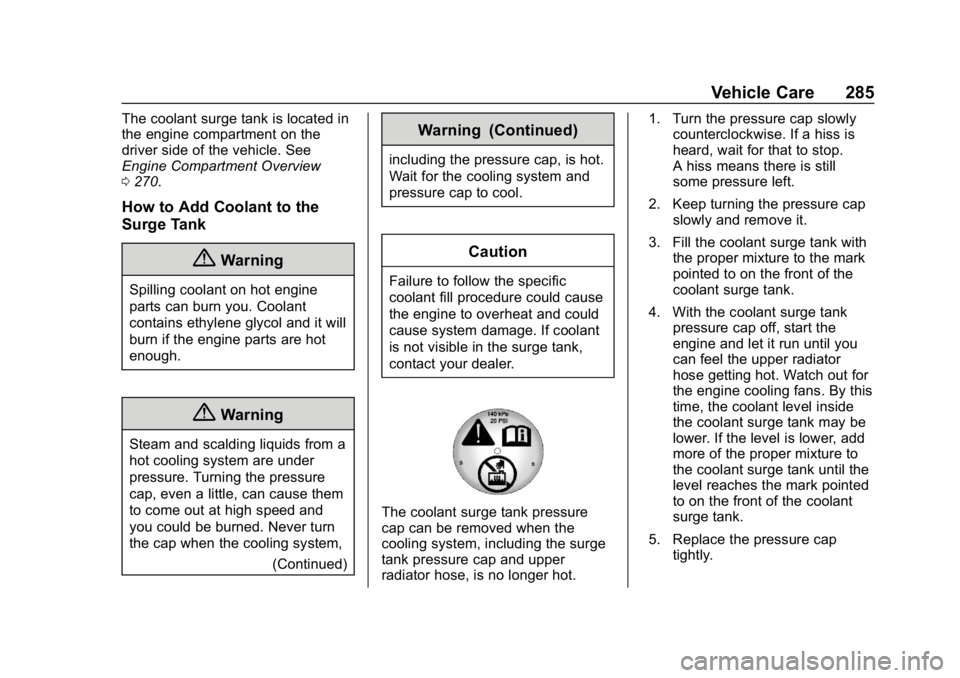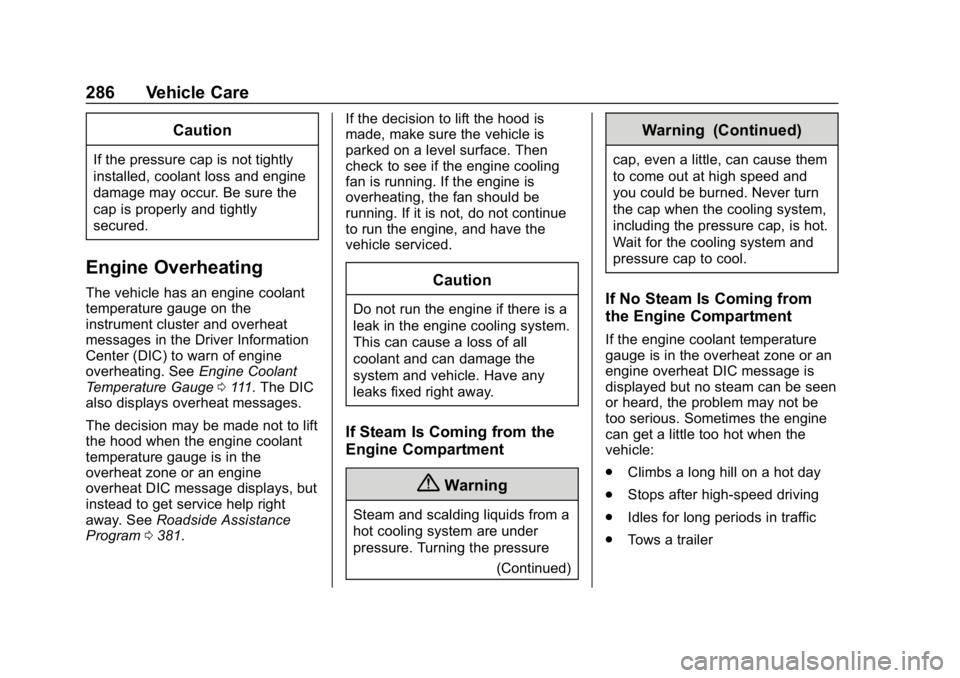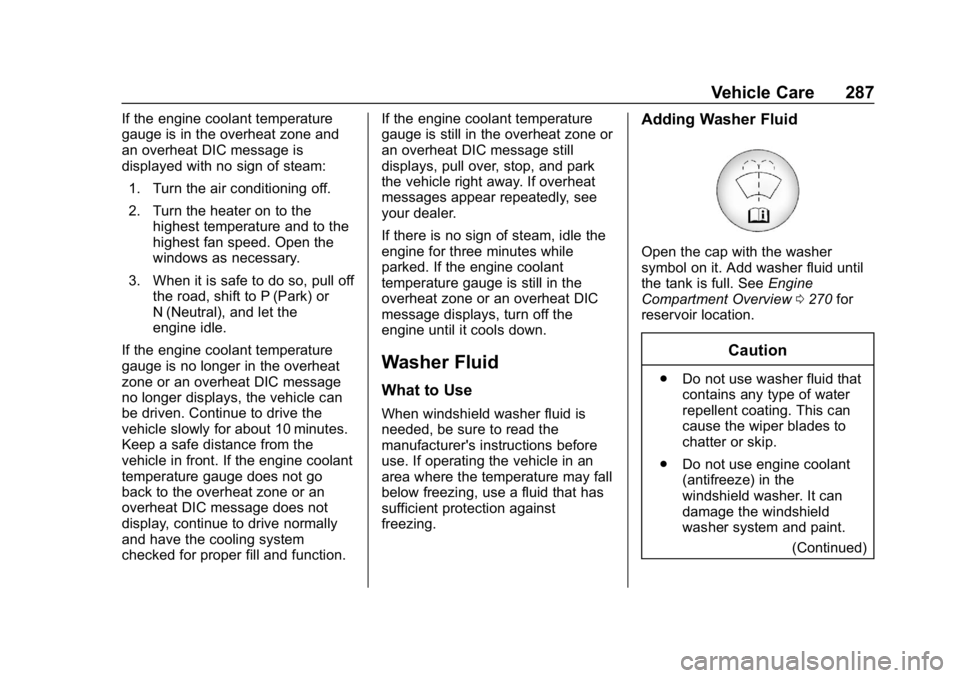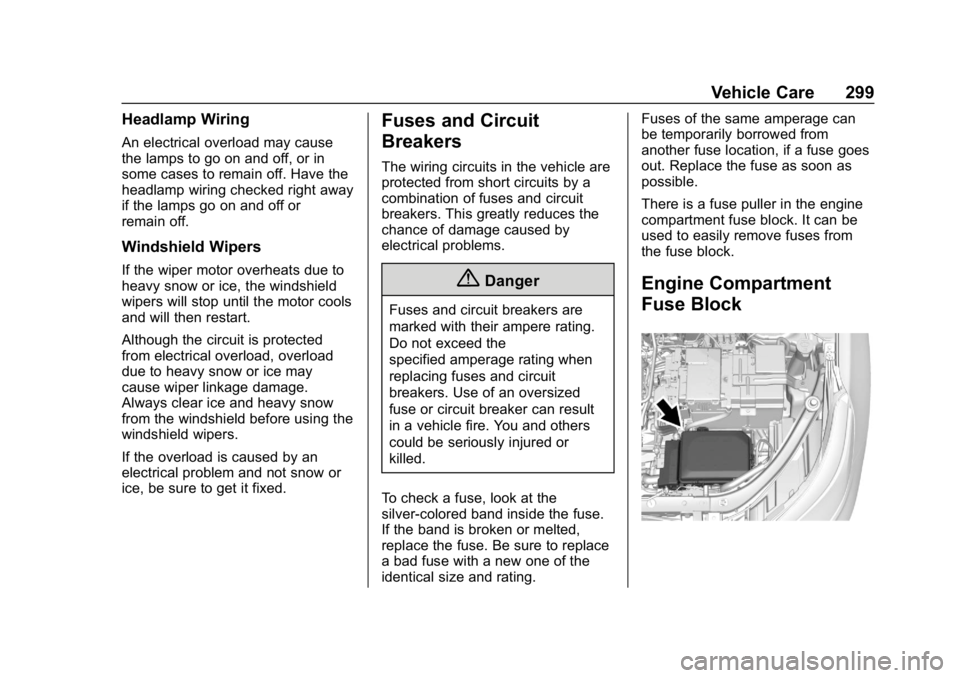2020 CHEVROLET EQUINOX engine overheat
[x] Cancel search: engine overheatPage 284 of 415

Chevrolet Equinox Owner Manual (GMNA-Localizing-U.S./Canada/Mexico-
13555863) - 2020 - CRC - 8/2/19
Vehicle Care 283
2.0L Gas Engine
1. Engine Cooling Fan (Outof View)
2. Engine Coolant Surge Tank and Pressure Cap
{Warning
An underhood electric fan can
start up even when the engine is
not running and can cause injury.
Keep hands, clothing, and tools
away from any underhood
electric fan. If the coolant inside the coolant
surge tank is boiling, do not do
anything else until it cools down.
The vehicle should be parked on a
level surface.
The coolant level should be at the
top rib on the middle of the tank. If it
is not, the vehicle may have a leak
at the radiator hoses, heater hoses,
radiator, water pump, or somewhere
else in the cooling system.
{Warning
Do not touch heater or radiator
hoses, or other engine parts.
They can be very hot and can
burn you. Do not run the engine if
there is a leak; all coolant could
leak out. That could cause an
engine fire and can burn you. Fix
any leak before driving the
vehicle.
If there seems to be no leak, with
the engine on, check to see if the
electric engine cooling fan is
running. If the engine is overheating, the fan should be
running. If it is not, the vehicle
needs service. Turn off the engine.
Engine Coolant
The engine cooling system in the
vehicle is filled with DEX-COOL
engine coolant mixture. This coolant
needs to be checked and changed
at appropriate levels. See
Recommended Fluids and
Lubricants
0369 and
Maintenance Schedule 0360.
The following explains the cooling
system and how to check and add
coolant when it is low. If there is a
problem with engine overheating,
see Engine Overheating 0286.
What to Use
{Warning
Plain water, or other liquids such
as alcohol, can boil before the
proper coolant mixture will. With
plain water or the wrong mixture,
the engine could get too hot but
(Continued)
Page 285 of 415

Chevrolet Equinox Owner Manual (GMNA-Localizing-U.S./Canada/Mexico-
13555863) - 2020 - CRC - 8/2/19
284 Vehicle Care
Warning (Continued)
there would not be an overheat
warning. The engine could catch
fire and you or others could be
burned.
Use a 50/50 mixture of clean,
drinkable water and DEX-COOL
coolant. If using this mixture,
nothing else needs to be added.
This mixture:
. Gives freezing protection down
to−37 °C (−34 °F), outside
temperature.
. Gives boiling protection up to
129 °C (265 °F), engine
temperature.
. Protects against rust and
corrosion.
. Will not damage aluminum parts.
. Helps keep the proper engine
temperature.
Caution
Do not use anything other than a
mix of DEX-COOL coolant that
meets GM Standard
GMW3420 and clean, drinkable
water. Anything else can cause
damage to the engine cooling
system and the vehicle, which
would not be covered by the
vehicle warranty.
Never dispose of engine coolant by
putting it in the trash, pouring it on
the ground, or pouring into sewers,
streams, or bodies of water. Have
the coolant changed by an
authorized service center, familiar
with legal requirements regarding
used coolant disposal. This will help
protect the environment and your
health.
Checking Coolant
The vehicle must be on a level
surface when checking the coolant
level.
Check to see if coolant is visible in
the coolant surge tank. If the coolant
inside the coolant surge tank is
boiling, do not do anything else until
it cools down. If coolant is visible
but the coolant level mark is not
visible, add a 50/50 mixture of
clean, drinkable water and
DEX-COOL coolant at the coolant
surge tank to the top rib on the
middle of the tank, but be sure the
cooling system is cool before this is
done. See Engine Overheating
0 286.
Page 286 of 415

Chevrolet Equinox Owner Manual (GMNA-Localizing-U.S./Canada/Mexico-
13555863) - 2020 - CRC - 8/2/19
Vehicle Care 285
The coolant surge tank is located in
the engine compartment on the
driver side of the vehicle. See
Engine Compartment Overview
0270.
How to Add Coolant to the
Surge Tank
{Warning
Spilling coolant on hot engine
parts can burn you. Coolant
contains ethylene glycol and it will
burn if the engine parts are hot
enough.
{Warning
Steam and scalding liquids from a
hot cooling system are under
pressure. Turning the pressure
cap, even a little, can cause them
to come out at high speed and
you could be burned. Never turn
the cap when the cooling system,
(Continued)
Warning (Continued)
including the pressure cap, is hot.
Wait for the cooling system and
pressure cap to cool.
Caution
Failure to follow the specific
coolant fill procedure could cause
the engine to overheat and could
cause system damage. If coolant
is not visible in the surge tank,
contact your dealer.
The coolant surge tank pressure
cap can be removed when the
cooling system, including the surge
tank pressure cap and upper
radiator hose, is no longer hot. 1. Turn the pressure cap slowly
counterclockwise. If a hiss is
heard, wait for that to stop.
A hiss means there is still
some pressure left.
2. Keep turning the pressure cap slowly and remove it.
3. Fill the coolant surge tank with the proper mixture to the mark
pointed to on the front of the
coolant surge tank.
4. With the coolant surge tank pressure cap off, start the
engine and let it run until you
can feel the upper radiator
hose getting hot. Watch out for
the engine cooling fans. By this
time, the coolant level inside
the coolant surge tank may be
lower. If the level is lower, add
more of the proper mixture to
the coolant surge tank until the
level reaches the mark pointed
to on the front of the coolant
surge tank.
5. Replace the pressure cap tightly.
Page 287 of 415

Chevrolet Equinox Owner Manual (GMNA-Localizing-U.S./Canada/Mexico-
13555863) - 2020 - CRC - 8/2/19
286 Vehicle Care
Caution
If the pressure cap is not tightly
installed, coolant loss and engine
damage may occur. Be sure the
cap is properly and tightly
secured.
Engine Overheating
The vehicle has an engine coolant
temperature gauge on the
instrument cluster and overheat
messages in the Driver Information
Center (DIC) to warn of engine
overheating. SeeEngine Coolant
Temperature Gauge 0111. The DIC
also displays overheat messages.
The decision may be made not to lift
the hood when the engine coolant
temperature gauge is in the
overheat zone or an engine
overheat DIC message displays, but
instead to get service help right
away. See Roadside Assistance
Program 0381. If the decision to lift the hood is
made, make sure the vehicle is
parked on a level surface. Then
check to see if the engine cooling
fan is running. If the engine is
overheating, the fan should be
running. If it is not, do not continue
to run the engine, and have the
vehicle serviced.Caution
Do not run the engine if there is a
leak in the engine cooling system.
This can cause a loss of all
coolant and can damage the
system and vehicle. Have any
leaks fixed right away.
If Steam Is Coming from the
Engine Compartment
{Warning
Steam and scalding liquids from a
hot cooling system are under
pressure. Turning the pressure
(Continued)
Warning (Continued)
cap, even a little, can cause them
to come out at high speed and
you could be burned. Never turn
the cap when the cooling system,
including the pressure cap, is hot.
Wait for the cooling system and
pressure cap to cool.
If No Steam Is Coming from
the Engine Compartment
If the engine coolant temperature
gauge is in the overheat zone or an
engine overheat DIC message is
displayed but no steam can be seen
or heard, the problem may not be
too serious. Sometimes the engine
can get a little too hot when the
vehicle:
.Climbs a long hill on a hot day
. Stops after high-speed driving
. Idles for long periods in traffic
. Tows a trailer
Page 288 of 415

Chevrolet Equinox Owner Manual (GMNA-Localizing-U.S./Canada/Mexico-
13555863) - 2020 - CRC - 8/2/19
Vehicle Care 287
If the engine coolant temperature
gauge is in the overheat zone and
an overheat DIC message is
displayed with no sign of steam:1. Turn the air conditioning off.
2. Turn the heater on to the highest temperature and to the
highest fan speed. Open the
windows as necessary.
3. When it is safe to do so, pull off the road, shift to P (Park) or
N (Neutral), and let the
engine idle.
If the engine coolant temperature
gauge is no longer in the overheat
zone or an overheat DIC message
no longer displays, the vehicle can
be driven. Continue to drive the
vehicle slowly for about 10 minutes.
Keep a safe distance from the
vehicle in front. If the engine coolant
temperature gauge does not go
back to the overheat zone or an
overheat DIC message does not
display, continue to drive normally
and have the cooling system
checked for proper fill and function. If the engine coolant temperature
gauge is still in the overheat zone or
an overheat DIC message still
displays, pull over, stop, and park
the vehicle right away. If overheat
messages appear repeatedly, see
your dealer.
If there is no sign of steam, idle the
engine for three minutes while
parked. If the engine coolant
temperature gauge is still in the
overheat zone or an overheat DIC
message displays, turn off the
engine until it cools down.
Washer Fluid
What to Use
When windshield washer fluid is
needed, be sure to read the
manufacturer's instructions before
use. If operating the vehicle in an
area where the temperature may fall
below freezing, use a fluid that has
sufficient protection against
freezing.
Adding Washer Fluid
Open the cap with the washer
symbol on it. Add washer fluid until
the tank is full. See
Engine
Compartment Overview 0270 for
reservoir location.
Caution
. Do not use washer fluid that
contains any type of water
repellent coating. This can
cause the wiper blades to
chatter or skip.
. Do not use engine coolant
(antifreeze) in the
windshield washer. It can
damage the windshield
washer system and paint.
(Continued)
Page 300 of 415

Chevrolet Equinox Owner Manual (GMNA-Localizing-U.S./Canada/Mexico-
13555863) - 2020 - CRC - 8/2/19
Vehicle Care 299
Headlamp Wiring
An electrical overload may cause
the lamps to go on and off, or in
some cases to remain off. Have the
headlamp wiring checked right away
if the lamps go on and off or
remain off.
Windshield Wipers
If the wiper motor overheats due to
heavy snow or ice, the windshield
wipers will stop until the motor cools
and will then restart.
Although the circuit is protected
from electrical overload, overload
due to heavy snow or ice may
cause wiper linkage damage.
Always clear ice and heavy snow
from the windshield before using the
windshield wipers.
If the overload is caused by an
electrical problem and not snow or
ice, be sure to get it fixed.
Fuses and Circuit
Breakers
The wiring circuits in the vehicle are
protected from short circuits by a
combination of fuses and circuit
breakers. This greatly reduces the
chance of damage caused by
electrical problems.
{Danger
Fuses and circuit breakers are
marked with their ampere rating.
Do not exceed the
specified amperage rating when
replacing fuses and circuit
breakers. Use of an oversized
fuse or circuit breaker can result
in a vehicle fire. You and others
could be seriously injured or
killed.
To check a fuse, look at the
silver-colored band inside the fuse.
If the band is broken or melted,
replace the fuse. Be sure to replace
a bad fuse with a new one of the
identical size and rating. Fuses of the same amperage can
be temporarily borrowed from
another fuse location, if a fuse goes
out. Replace the fuse as soon as
possible.
There is a fuse puller in the engine
compartment fuse block. It can be
used to easily remove fuses from
the fuse block.
Engine Compartment
Fuse Block
Page 406 of 415

Chevrolet Equinox Owner Manual (GMNA-Localizing-U.S./Canada/Mexico-
13555863) - 2020 - CRC - 8/2/19
Index 405
Dome Lamps . . . . . . . . . . . . . . . . . . . 149
DoorDelayed Locking . . . . . . . . . . . . . . . . 19
Locks . . . . . . . . . . . . . . . . . . . . . . . . . . . 16
Power Locks . . . . . . . . . . . . . . . . . . . . 19
Drive Belt Routing, Engine . . . . . . 376
Drive Systems All-Wheel Drive . . . . . . . . . . 204, 291
Driver Assistance Systems . . . . . 225
Driver Behavior . . . . . . . . . . . . . . . . . 163
Driver Information Center (DIC) . . . . . . . . . . . . . 123, 129
Driving Assistance Systems . . . . . . . . . . 230
Better Fuel Economy . . . . . . . . . 164
Characteristics andTowing Tips . . . . . . . . . . . . . . . . . 254
Defensive . . . . . . . . . . . . . . . . . . . . . 165
Drunk . . . . . . . . . . . . . . . . . . . . . . . . . 165
Environment . . . . . . . . . . . . . . . . . . 164
Hill and Mountain Roads . . . . . . 173
If the Vehicle is Stuck . . . . . . . . . 175
Loss of Control . . . . . . . . . . . . . . . 168
Off-Road . . . . . . . . . . . . . . . . . . . . . 168
Off-Road Recovery . . . . . . . . . . . 167
Vehicle Load Limits . . . . . . . . . . . 176
Wet Roads . . . . . . . . . . . . . . . . . . . 172
Winter . . . . . . . . . . . . . . . . . . . . . . . . 174 Driving the Vehicle . . . . . . . . . . . . . . . . 2
Dual Automatic Climate
Control System . . . . . . . . . . . . . . . . 156
E
Electric Parking Brake . . . . . . . . . . 205
Electric Parking Brake Light . . . . 117
Electrical Equipment,Add-On . . . . . . . . . . . . . . . . . . . . . . . 263
Electrical System Engine Compartment FuseBlock . . . . . . . . . . . . . . . . . . . . . . . . 299
Fuses and Circuit Breakers . . . 299
Instrument Panel Fuse Block . . . . . . . . . . . . . . . . . . . . . . . . 302
Overload . . . . . . . . . . . . . . . . . . . . . 298
Rear Compartment Fuse Block . . . . . . . . . . . . . . . . . . . . . . . . 305
Emergency OnStar . . . . . . . . . . . . . . . . . . . . . . . 392
Engine
Air Cleaner/Filter . . . . . . . . . . . . . 280
Check Light (MalfunctionIndicator) . . . . . . . . . . . . . . . . . . . . .114
Compartment Overview . . . . . . . 270
Coolant Temperature Gauge . . . . . . . . . . . . . . . . . . . . . . . 111
Cooling System . . . . . . . . . . . . . . . 282 Engine (cont'd)
Drive Belt Routing . . . . . . . . . . . . 376
Exhaust . . . . . . . . . . . . . . . . . . . . . . 190
Heater . . . . . . . . . . . . . . . . . . . . . . . . 187
Oil Life System . . . . . . . . . . . . . . . 279
Oil Pressure Light . . . . . . . . . . . . 121
Overheating . . . . . . . . . . . . . . . . . . 286
Power Messages . . . . . . . . . . . . . 134
Running While Parked . . . . . . . . 191
Starting . . . . . . . . . . . . . . . . . . . . . . . 182
Engines Diesel Fuel . . . . . . . . . . . . . . . . . . . 243
Entry Lighting . . . . . . . . . . . . . . . . . . . 151
Equipment, Towing . . . . . . . . . . . . . 261
Event Data Recorders . . . . . . . . . . 389
Exhaust Fluid Diesel . . . . . . . . . . . . . . . . . . . . . . . . 195
Exit Lighting . . . . . . . . . . . . . . . . . . . . 151
Extended Parking . . . . . . . . . . . . . . . 190
Extender, Seat Belt . . . . . . . . . . . . . . 55
Exterior Lamp Controls . . . . . . . . . 144
Exterior Lighting Battery Saver . . . . . . . . . . . . . . . . . . . . . . . . . 152
F
Filter . . . . . . . . . . . . . . . . . . . . . . . . . . . . 191
Replacement (Fuel) . . . . . . . . . . . 249
Page 410 of 415

Chevrolet Equinox Owner Manual (GMNA-Localizing-U.S./Canada/Mexico-
13555863) - 2020 - CRC - 8/2/19
Index 409
N
NavigationConnected Services . . . . . . . . . . 399
Net, Convenience . . . . . . . . . . . . . . . 91
New Vehicle Break-In . . . . . . . . . . . 180
O
Odometer . . . . . . . . . . . . . . . . . . . . . . . 109 Trip . . . . . . . . . . . . . . . . . . . . . . . . . . . 109
Off-Road . . . . . . . . . . . . . . . . . . . . . . . 168 Driving . . . . . . . . . . . . . . . . . . . . . . . . 168
Recovery . . . . . . . . . . . . . . . . . . . . . 167
Oil Engine . . . . . . . . . . . . . . . . . . . . . . . . 275
Engine Oil Life System . . . . . . . 279
Pressure Light . . . . . . . . . . . . . . . . 121
Older Children, Restraints . . . . . . . 68
Online Owner Center . . . . . . . . . . . 380
OnStar . . . . . . . . . . . . . . . . . . . . . . . . . 390
OnStar Additional Information . . . . . . . . . . . . . . . . . . . . 393
OnStar Emergency . . . . . . . . . . . . . 392
OnStar Overview . . . . . . . . . . . . . . . 391
OnStar Security . . . . . . . . . . . . . . . . 393
Operation Fog Lamps . . . . . . . . . . . . . . . . . . . 148
Outlets Power . . . . . . . . . . . . . . . . . . . . . . . . . . 97 Overheating, Engine . . . . . . . . . . . . 286
Overview
Instrument Panel . . . . . . . . . . . . . . . . 5
P
ParkShifting Out of . . . . . . . . . . . . . . . . 189
Park Assist . . . . . . . . . . . . . . . . . . . . . 226
Parking Brake and P (Park)Mechanism Check . . . . . . . . . . 292
Extended . . . . . . . . . . . . . . . . . . . . . 190
Over Things That Burn . . . . . . . 190
Parking or Backing Assistance Systems . . . . . . . . . . 226
Passenger Airbag Status Indicator . . . . . . . . . . . . . . . . . . . . . . 113
Passenger Compartment Air Filter . . . . . . . . . . . . . . . . . . . . . . . . . . 160
Passenger Sensing System . . . . . 62
Pedestrian Ahead Indicator . . . . . 119
Perchlorate Materials Requirements, California . . . . . . 267
Personalization Vehicle . . . . . . . . . . . . . . . . . . . . . . . 134
Power
Door Locks . . . . . . . . . . . . . . . . . . . . . 19
Mirrors . . . . . . . . . . . . . . . . . . . . . . . . . . 28 Power (cont'd)
Outlets . . . . . . . . . . . . . . . . . . . . . . . . . 97
Protection, Battery . . . . . . . . . . . . 152
Retained Accessory (RAP) . . . 188
Seat Adjustment . . . . . . . . . . . . . . . . 38
Windows . . . . . . . . . . . . . . . . . . . . . . . 30
Pregnancy, Using Seat Belts . . . . 54
Privacy Vehicle Data Recording . . . . . . . 389
Program Courtesy Transportation . . . . . . 383
Prohibited Fuels . . . . . . . . . . . . . . . . 242
Proposition 65 Warning,
California . . . . . . . . . . . .266, 290, 341,
Back Cover
Publication Ordering Information . . . . . . . . . . . . . . . . . . . . 386
R
Radio Frequency Statement . . . . 387
Reading Lamps . . . . . . . . . . . . . . . . . 150
Rear Compartment/StoragePanel Cover . . . . . . . . . . . . . . . . . . . . 89
Rear Seats . . . . . . . . . . . . . . . . . . . . . . 44 Heated . . . . . . . . . . . . . . . . . . . . . . . . . 47
Rear Vision Camera (RVC) . . . . . 226
Rear Window Washer/Wiper . . . . . 96